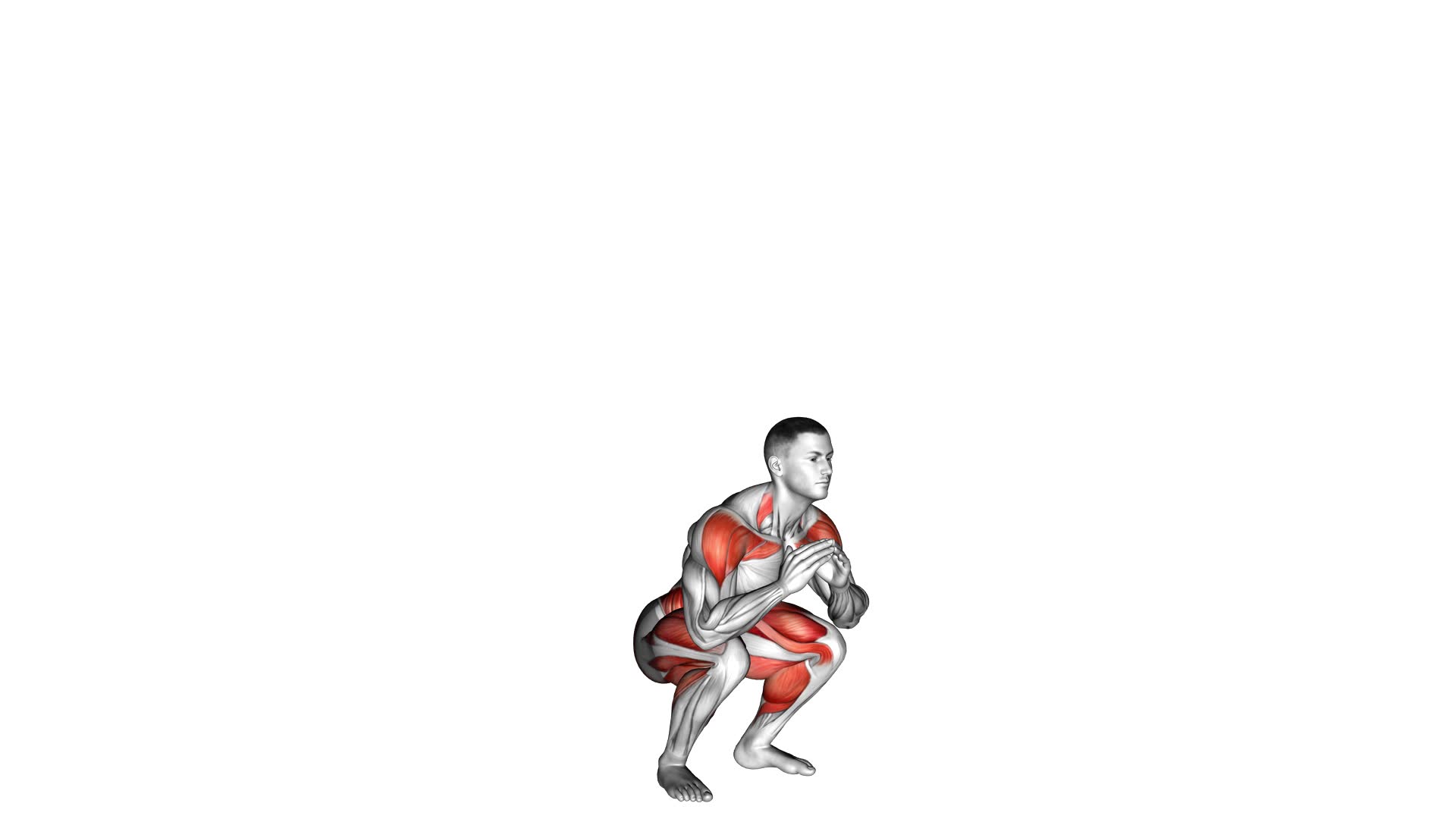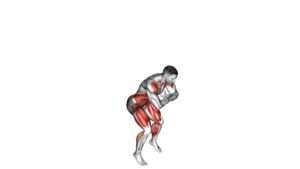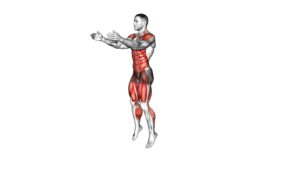Squat Tuck Jump – Video Exercise Guide & Tips

Get ready to level up your workout with the Squat Tuck Jump! This explosive exercise targets your lower body and core, giving you a total body burn.
Watch This Exercise Video
In this video exercise guide, we'll show you the proper form and technique, common mistakes to avoid, modifications for beginners, and advanced variations for seasoned athletes.
Plus, we've got expert tips to help you maximize your results.
So grab your mat and get ready to jump into action!
Key Takeaways
- Squat tuck jumps increase explosive power and improve lower body strength.
- They also enhance cardiovascular endurance and target the quadriceps, hamstrings, glutes, and calf muscles.
- Engaging core muscles for stability and balance is important during squat tuck jumps.
- Proper form and technique, as well as injury prevention tips, should be followed to minimize the risk of injury and maximize results.
Benefits of the Squat Tuck Jump
You can experience increased explosive power and improve lower body strength with the Squat Tuck Jump. This exercise isn't only beneficial for building muscle, but it also enhances cardiovascular endurance. By incorporating explosive movements into your workout routine, you can improve your overall athletic performance.
The Squat Tuck Jump primarily targets your quadriceps, hamstrings, glutes, and calf muscles. As you explode off the ground, your muscles are forced to work harder, resulting in increased power and strength. This exercise also engages your core muscles, helping to improve stability and balance.
In addition to building strength, the Squat Tuck Jump is a great way to boost your cardiovascular endurance. The rapid, explosive movements require considerable effort and increase your heart rate, leading to improved cardiovascular health.
To perform the Squat Tuck Jump, start by standing with your feet shoulder-width apart. Lower your body into a squat position, ensuring your knees are in line with your toes. From here, explosively jump into the air while bringing your knees up towards your chest. Land softly back into the squat position and repeat for the desired number of repetitions.
Incorporating the Squat Tuck Jump into your workout routine can help you develop explosive power and improve your lower body strength. Don't forget to warm up before attempting this exercise and listen to your body to avoid injury.
Proper Form and Technique
To ensure proper form and technique for the Squat Tuck Jump, it's important to focus on maintaining proper alignment and engaging the correct muscles throughout the exercise. Here are some key points to keep in mind:
- Start in a standing position with your feet shoulder-width apart and toes pointing forward.
- Lower your body into a squat position by bending your knees and pushing your hips back, keeping your chest lifted and your spine neutral.
- As you explode upwards, tuck your knees towards your chest and extend your arms forward for balance.
- Land softly on the balls of your feet, absorbing the impact with your leg muscles.
By maintaining proper alignment and engaging the correct muscles, you can maximize the effectiveness of the Squat Tuck Jump and minimize the risk of injury.
Common errors to avoid include:
- Allowing your knees to collapse inward during the squat and jump.
- Not fully extending your hips and knees during the jump.
- Landing with your knees locked or landing too heavily, which can strain your joints.
By focusing on proper form and technique, you can safely and effectively incorporate the Squat Tuck Jump into your workout routine.
Now let's explore some common mistakes to avoid for optimal results.
Common Mistakes to Avoid
To ensure you perform the squat tuck jump correctly and prevent any potential injuries, it's important to pay attention to proper form demonstration and follow injury prevention tips.
By watching a video or seeking guidance from a fitness professional, you can learn the correct technique, including the proper alignment of your body, the depth of your squat, and the explosive power needed for the tuck jump.
Additionally, make sure to warm up properly, listen to your body, and avoid overexertion to minimize the risk of injury.
Proper Form Demonstration
To demonstrate proper form and avoid common mistakes, ensure that your squat tuck jump is executed with explosive power and precision. Here are some key tips to help you perform the exercise correctly:
- Keep your feet shoulder-width apart and toes pointed slightly outward.
- Bend your knees and lower into a squat position, making sure your thighs are parallel to the ground.
As you explode upward, tuck your knees towards your chest, bringing them as close as possible.
- Land softly on the balls of your feet, with your knees slightly bent to absorb the impact.
By following these guidelines, you can minimize the risk of injury and maximize the effectiveness of the squat tuck jump.
Remember to always listen to your body and start with a lower intensity before progressing to more advanced variations.
Injury Prevention Tips
To prevent injuries, make sure you're aware of common mistakes to avoid while performing the squat tuck jump.
Before starting the exercise, it's important to warm up your body with some dynamic warm-up exercises, such as leg swings or jumping jacks. This helps to increase blood flow and prepare your muscles for the intense movement of the squat tuck jump.
Additionally, incorporating stretching techniques into your routine can improve flexibility and reduce the risk of muscle strains or tears. Focus on stretching the muscles involved in the squat tuck jump, such as the quadriceps, hamstrings, and glutes.
Remember to maintain proper form throughout the exercise to avoid putting unnecessary stress on your joints and muscles.
Modifications for Beginners
When starting out with the squat tuck jump, it's important to begin with simplified squat variations to build strength and stability.
As a beginner, it's also crucial to gradually increase the intensity of the exercise over time to avoid injuries.
Proper form guidance is essential to ensure you're performing the exercise correctly and getting the most out of your workout.
Simplified Squat Variations
Start with a basic squat to build strength and endurance as a beginner. Here are some simplified squat variations that can help you progress and prevent injuries:
- Wall Squat: Stand with your back against a wall and slowly slide down into a squat position, keeping your knees aligned with your toes.
- Chair Squat: Sit on a chair and stand up without using your hands, focusing on engaging your leg muscles.
- Box Squat: Use a sturdy box or step to perform squats, gradually lowering the height as you gain strength.
- Goblet Squat: Hold a dumbbell or kettlebell close to your chest as you perform squats, which helps improve form and stability.
By starting with these simplified variations, you can gradually build up your strength and technique, preparing yourself for more intense squat exercises.
Now, let's dive into the next section and explore gradual intensity progression.
Gradual Intensity Progression
As a beginner, you should gradually increase the intensity of your squat exercises to build strength and endurance. This not only helps prevent injuries but also maximizes your results.
When starting out, it's important to focus on proper form and technique before progressing to more challenging variations. Begin with bodyweight squats, ensuring that you're maintaining a neutral spine and engaging your core.
As you become more comfortable, you can add resistance by using dumbbells or a barbell. Another modification for beginners is to decrease the range of motion by performing partial squats. This allows you to gradually build up your strength and mobility.
Remember to listen to your body and progress at a pace that feels comfortable for you.
Proper Form Guidance
To ensure proper form and avoid injuries, beginners can make modifications to their squat exercises. Here are some tips to help you perform squats with correct form and prevent injuries:
- Start with bodyweight squats: Begin by mastering the basic squat movement without any additional weight. This will help you build a strong foundation and work on your form.
- Focus on technique: Pay attention to your form during each rep. Keep your chest up, back straight, and knees in line with your toes. Avoid rounding your back or letting your knees cave inwards.
- Use a wider stance: If you find it challenging to maintain proper form, try widening your stance slightly. This can help with stability and balance.
- Gradually increase intensity: As you become more comfortable with the movement, you can begin adding weight to your squats. Start with light dumbbells or a barbell and gradually increase the load.
Advanced Variations for Seasoned Athletes
Challenge yourself with advanced variations of the squat tuck jump to enhance your athletic performance. These advanced modifications will take your explosive power training to the next level.
One advanced variation is the weighted squat tuck jump. To perform this exercise, hold a dumbbell or kettlebell in each hand at shoulder level while executing the squat tuck jump. The added weight increases the resistance and intensity, demanding more power from your muscles.
Another advanced variation is the single-leg squat tuck jump. This exercise requires exceptional balance and stability. Start by balancing on one leg, then perform the squat tuck jump using only that leg. Switch legs and repeat the exercise to work both sides equally.
For an even greater challenge, try the depth jump into squat tuck jump. Begin by standing on a raised platform, then step off and immediately transition into a squat tuck jump upon landing. This variation incorporates plyometric training, enhancing your explosive power and agility.
Tips for Maximizing Your Results
To maximize your results, focus on proper technique and consistency when performing the squat tuck jump and its advanced variations. Here are some tips to help you get the most out of your workouts:
- Maintain proper form: Make sure to keep your knees in line with your toes and your back straight throughout the exercise. This will help prevent injuries and ensure that you're targeting the right muscles.
- Progress tracking: Keep track of your progress by recording the number of reps and sets you complete, as well as any modifications you make to the exercise. This will allow you to see how far you've come and make adjustments to your routine as needed.
- Increase workout frequency gradually: Start by incorporating the squat tuck jump into your workout routine 1-2 times per week and gradually increase the frequency as you build strength and endurance. This will help prevent overtraining and allow your body to properly recover.
- Listen to your body: Pay attention to any pain or discomfort during the exercise. If something doesn't feel right, don't push through it. Take a break, modify the exercise, or consult with a fitness professional for guidance.
Frequently Asked Questions
How Many Calories Can You Burn Doing Squat Tuck Jumps?
When you do squat tuck jumps, you can burn a significant amount of calories. The exact number of calories burned will vary depending on factors such as your weight, intensity, and duration of the exercise.
Squat tuck jumps are a high-intensity exercise that engages multiple muscle groups, making it an efficient calorie-burning exercise.
To increase or decrease the intensity, you can modify the exercise by adjusting the depth of your squat or the height of your jump.
Can Squat Tuck Jumps Help Improve Vertical Jump Height?
To improve your vertical jump height, incorporating plyometric exercises like squat tuck jumps can be beneficial. These explosive movements engage your leg muscles and help increase your power and explosiveness.
However, if you have a knee injury or are in rehabilitation, it's important to consult with a professional and consider alternative exercises that are safe and suitable for your condition. Remember to prioritize proper form and technique to avoid further injury.
Are Squat Tuck Jumps Suitable for People With Knee Injuries?
Squat tuck jumps can be modified to suit people with knee injuries. By reducing the depth of the squat and the intensity of the jump, you can still benefit from this exercise while protecting your knees.
Squat tuck jumps are great for improving overall fitness as they target multiple muscle groups, including the quads, hamstrings, and glutes. They also help improve explosive power and cardiovascular endurance.
However, it's important to consult with a healthcare professional before attempting this exercise if you have a knee injury.
What Muscles Are Targeted When Performing Squat Tuck Jumps?
When you perform squat tuck jumps, several muscles are targeted. Your quadriceps, hamstrings, glutes, and calves all work together to generate power and explosiveness.
These exercises also engage your core muscles, including your abs and lower back, to stabilize your body during the movement.
Squat tuck jumps are a great way to improve your overall athleticism, as they enhance your strength, agility, and coordination.
Incorporating them into your training routine can lead to better performance in various sports and activities.
How Often Should Squat Tuck Jumps Be Incorporated Into a Workout Routine?
To determine how often you should incorporate squat tuck jumps into your workout routine, consider your fitness level and goals. These explosive plyometric exercises can help improve power and burn calories.
However, due to their high impact nature, they may not be suitable for individuals with knee injuries. If you have a knee injury, it's crucial to modify the exercise or consult with a healthcare professional to prevent further damage.
Conclusion
To conclude, the squat tuck jump is an effective exercise for improving lower body strength and explosiveness.
By maintaining proper form and technique, avoiding common mistakes, and gradually progressing to advanced variations, athletes of all levels can benefit from this exercise.
Remember to listen to your body, make modifications if needed, and always strive for proper execution to maximize your results.

Author
Years ago, the spark of my life’s passion ignited in my mind the moment I stepped into the local gym for the first time. The inaugural bead of perspiration, the initial endeavor, the very first surge of endorphins, and a sense of pride that washed over me post-workout marked the beginning of my deep-seated interest in strength sports, fitness, and sports nutrition. This very curiosity blossomed rapidly into a profound fascination, propelling me to earn a Master’s degree in Physical Education from the Academy of Physical Education in Krakow, followed by a Sports Manager diploma from the Jagiellonian University. My journey of growth led me to gain more specialized qualifications, such as being a certified personal trainer with a focus on sports dietetics, a lifeguard, and an instructor for wellness and corrective gymnastics. Theoretical knowledge paired seamlessly with practical experience, reinforcing my belief that the transformation of individuals under my guidance was also a reflection of my personal growth. This belief holds true even today. Each day, I strive to push the boundaries and explore new realms. These realms gently elevate me to greater heights. The unique combination of passion for my field and the continuous quest for growth fuels my drive to break new ground.







